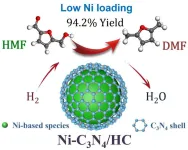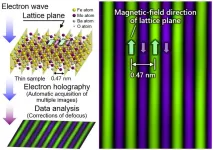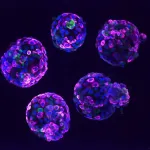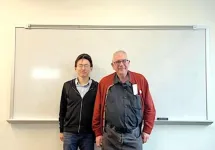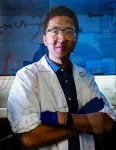(Press-News.org) This accolade highlights her pioneering research in the use of a diverse array of advanced microscopy techniques to uncover fundamental biophysical processes.
Currently holding a prestigious EMBL (European Molecular Biology Laboratory) Australia Group Leader fellowship, Dr Ananthanarayanan leads one of the largest and most dynamic research group in the EMBL Australia Node in Single Molecule Science, based in the Department of Molecular Medicine in the School of Biomedical Sciences.
Her research, which focuses on motor proteins and cytoskeleton dynamics, has set new standards in the field and underscores the power of microscopy in addressing critical questions in cell biology. These questions include investigation of the molecular underpinnings of neurodegeneration, cellular decision-making that dictates overgrowth of cells in cancer, and the signalling itinerary of psychedelics in cells that leads to their anti-depressant properties.
Dr Ananthanarayanan’s academic journey began with a PhD from the Max Planck Institute of Molecular Cell Biology and Genetics in Germany, followed by a successful tenure at the Indian Institute of Science in Bangalore, where she was promoted to Assistant Professor.
Her work has been published in multiple prestigious journals and she has received the EMBO Young Investigator Award (2019) and the ASCB Junior Award for Excellence in Research (2021).
Dr Ananthanarayanan joined UNSW in November 2020 after being awarded a prestigious EMBL Australia Group Leader fellowship – UNSW’s fourth so far.
Her dedication extends beyond biomedical research; she is a passionate educator and mentor, having supervised numerous PhD, MSc, and undergraduate Honours students. She is also a strong advocate for equity and inclusion.
Dr Ananthanarayanan has championed the culture shift in academic science as the co-founder of BiasWatchIndia – an organisation that advocates for equal gender representation in Indian conference symposia and discussion panels. She has also been a positive role model in her department through her work to establish a journal club and lead the conversation on equity, diversity, and inclusion.
Her recent achievements at UNSW include publishing several breakthrough research and review papers, and her team’s discovery on the transient interactions within cells driving complex processes has been particularly notable. In recognition of her contributions, she was named Researcher of the Year by the School of Biomedical Sciences in 2023.
Dr. Ananthanarayanan is the first recipient of the RMS Life Sciences Award outside of Europe. She joins some of the highest achieving and elite microscopists in life sciences to win this award, including Dr Anjali Kusumbe (University of Oxford; 2023), Dr Yanlan Mao (University College London; 2019) and Dr Cristina Lo Celso (Imperial College London; 2019).
END
UNSW Sydney's Dr Vaishnavi Ananthanarayanan receives RMS Award for Life Sciences
The Royal Microscopical Society's 2025 Life Sciences Award goes to Dr Ananthanarayanan, the first recipient of this award outside of Europe.
2024-07-04
ELSE PRESS RELEASES FROM THIS DATE:
Researchers unveils a critical role of the lateral septum in drug addiction
2024-07-04
Recently, a research team led by Dr. ZHU Yingjie from the Shenzhen Institute of Advanced Technology, Chinese Academy of Sciences has published a study in Neuron, the study presents a comprehensive transcriptional profile of the lateral septum (LS) at the single-cell level, elucidating the spatial distribution of its major neuronal types. The study shows that neurons expressing estrogen receptor 1 (LSEsr1), predominantly located in the ventral subregion of LS, play a crucial role in reward-seeking and methamphetamine (METH) addiction.
In 1954, psychologists Olds and Milner discovered the brain's reward system through intracranial ...
Efficient hydrogenolysis of 5-hydroxymethylfurfural over Ni-C3N4 catalysts
2024-07-04
Utilization of biomass as the basic feedstock for the production and chemicals and energy storage has been demonstrated to be an important alternative to achieve sustainable society, which has attracted increasing interests in both academic and industrial communities for decades. 5-hydroxymethylfurfural (HMF), one of the most important bio-based platform compounds, could serve as a bridge feedstock between biomass resources and chemicals. It is possible to synthesize a series of high-value added chemicals from HMF through hydrogenation, ...
Hitachi’s holography electron microscope attains unprecedented resolution
2024-07-04
Tokyo, Japan—A research team from Japan, including scientists from Hitachi, Ltd. (TSE 6501, Hitachi), Kyushu University, RIKEN, and HREM Research Inc. (HREM), has achieved a major breakthrough in the observation of magnetic fields at unimaginably small scales. In collaboration with National Institute of Advanced Industrial Science and Technology (AIST) and the National Institute for Materials Science (NIMS), the team used Hitachi’s atomic-resolution holography electron microscope—with a newly developed image acquisition technology and defocus correction algorithms—to visualize ...
An innovative test to diagnose chagas disease in newborns
2024-07-04
An innovative test that combines a DNA extraction system inspired by a modified 3D printer (PrintrLab) with loop-mediated isothermal molecular amplification (LAMP) could be used to detect T. cruzi infection -responsible for Chagas disease- in newborns. This is the conclusion of a proof-of-concept study conducted in the Bolivian Chaco, an endemic area for Chagas disease. The study was coordinated by the Barcelona Institute for Global Health (ISGlobal), a centre supported by "la Caixa" ...
Compact cities have lower carbon emissions, but poorer air quality, less green space and higher mortality rates
2024-07-04
What types of cities exist in Europe and which are more favourable in terms of human health, environmental quality and carbon footprint? To answer these questions, a study led by the Barcelona Institute for Global Health (ISGlobal), a centre supported by the "la Caixa" Foundation, has analysed 919 European cities. The research, published in The Lancet Planetary Health, identified four basic urban configurations on the continent: compact-high density cities, open lowrise-medium density cities, open lowrise-low density cities and green-low density cities. The results show that greener and less densely populated ...
Cuts to processed meat intake bring a range of health benefits
2024-07-04
Reducing consumption of processed meat by around one-third could prevent more than 350,000 cases of diabetes in the US over 10 years, a study suggests.
Cutting US adults’ processed meat intake by 30 per cent – the equivalent of around 10 slices of bacon a week – would also lead to tens of thousands of fewer cases of cardiovascular disease and colorectal cancer, researchers say.
A team from the University of Edinburgh’s Global Academy of Agriculture and Food Systems together with the University of North Carolina, Chapel Hill, has developed ...
Pioneering Code of Practice released for use of stem cell-based embryo models in research
2024-07-04
Stem cell-based embryo models (SCBEMs) are three-dimensional biological structures that mimic aspects of early human embryo development. They can be created in the lab from stem cells, and can provide new insights into critical stages of early human development that are normally inaccessible to researchers.
Embryo model work is expected to lead to new interventions for a range of conditions, including revolutionising treatments for recurrent miscarriage, understanding developmental disorders and improving the success rate of IVF.
Although embryo models are not the same ...
First study to measure toxic metals in tampons shows arsenic and lead, among other contaminants
2024-07-04
Tampons from several brands that potentially millions of people use each month can contain toxic metals like lead, arsenic, and cadmium, a new study led by a UC Berkeley researcher has found.
Tampons are of particular concern as a potential source of exposure to chemicals, including metals, because the skin of the vagina has a higher potential for chemical absorption than skin elsewhere on the body. In addition, the products are used by a large percentage of the population on a monthly basis—50-80% of those who menstruate use tampons—for several hours at a time.
“Despite this large potential for public health concern, very little research ...
Rice researchers uncover key mechanisms in chromosome structure development
2024-07-03
Researchers at Rice University are making strides in understanding how chromosome structures change throughout the cell’s life cycle. Their study on motorized processes that actively influence the organization of chromosomes was published in the Proceedings of the National Academy of Science.
“This research provides a deeper understanding of how motorized processes shape chromosome structures and influence cellular functions,” said Peter Wolynes, study co-author and the D.R. Bullard-Welch Foundation Professor of Science. ...
Rice research aims to reprogram the genetic code
2024-07-03
Rice University chemist Han Xiao has been awarded nearly $2 million from the National Institutes of Health Maximizing Investigators’ Research Award (MIRA) program for established investigators.
All organisms with few exceptions use 20 standard amino acids to build proteins. Xiao’s research aims to reprogram the genetic code to precisely manipulate biological systems by using noncanonical amino acids (ncAAs) with diverse properties to help build proteins. Researchers generally use ncAAs to investigate the structure and dynamics of proteins, but Xiao wants to take that a step further.
“This innovative approach could revolutionize how ...
LAST 30 PRESS RELEASES:
House sparrows in northern Norway can help us save other endangered animals
Crohn's & Colitis Foundation survey reveals more than 1/3 of young adults with IBD face step therapy insurance barriers
Tethered UAV autonomous knotting on environmental structures for transport
Decentralized social media platforms unlock authentic consumer feedback
American Pediatric Society announces Vanderbilt University School of Medicine as host institution for APS Howland Visiting Professor Program
Scientists discover first method to safely back up quantum information
A role for orange pigments in birds and human redheads
Pathways to net-zero greenhouse gas emissions for Southeast Asia
A JBNU–KIMS collaborative study on a cost-effective alloy matches superalloys for power plants and energy infrastructure
New study overturns long-held model of how plants coordinate immune responses.
New AI model predicts disease risk while you sleep
Scientists discover molecular ‘reshuffle’ and crack an 80-year-old conundrum
How stressors during pregnancy impact the developing fetal brain
Electrons lag behind the nucleus
From fungi to brain cells: one scientist's winding path reveals how epigenomics shapes neural destiny
Schizophrenia and osteoporosis share 195 genetic loci, highlighting unexpected biological bridges between brain and bone
Schizophrenia-linked genetic variant renders key brain receptor completely unresponsive to both natural and therapeutic compounds
Innovative review reveals overlooked complexity in cellular energy sensor's dual roles in Alzheimer's disease
Autism research reframed: Why heterogeneity is the data, not the noise
Brazil's genetic treasure trove: supercentenarians reveal secrets of extreme human longevity
The (metabolic) cost of life
CFRI special issue call for papers: New Frontiers in Sustainable Finance
HKU Engineering scholar demonstrates the smallest all-printed infrared photodetectors to date
Precision empowerment for brain "eavesdropping": CAS team develops triple-electrode integrated functional electrode for simultaneous monitoring of neural signals and chemical transmitters during sleep
Single-capillary endothelial dysfunction resolved by optoacoustic mesoscopy
HKU three research projects named among ‘Top 10 Innovation & Technology News in Hong Kong 2025’ showcasing excellence in research and technology transfer
NLRSeek: A reannotation-based pipeline for mining missing NLR genes in sequenced genomes
A strand and whole genome duplication–aware collinear gene identification tool
Light storage in light cages: A revolutionary approach to on-chip quantum memories
Point spread function decoupling in computational fluorescence microscopy
[Press-News.org] UNSW Sydney's Dr Vaishnavi Ananthanarayanan receives RMS Award for Life SciencesThe Royal Microscopical Society's 2025 Life Sciences Award goes to Dr Ananthanarayanan, the first recipient of this award outside of Europe.


